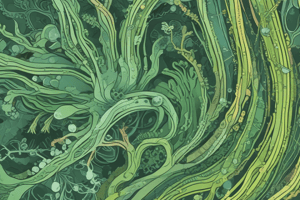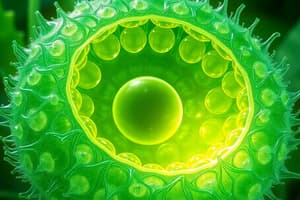Podcast
Questions and Answers
What kind of reproduction can Volvox undergo?
What kind of reproduction can Volvox undergo?
- Only sexual reproduction
- Only asexual reproduction
- Asexual or sexual reproduction (correct)
- Fission reproduction exclusively
What is the primary habitat of Ichthyobodo necator?
What is the primary habitat of Ichthyobodo necator?
- Marine environments
- Insect bodies
- Freshwater fish (correct)
- Terrestrial mammals
Which of the following statements about Trypanosomatids is true?
Which of the following statements about Trypanosomatids is true?
- They possess multiple flagella for movement.
- All members are parasitic and primarily found in insects. (correct)
- They are exclusively free-living organisms.
- They only cause diseases in plants.
Which disease is specifically caused by Trypanosoma cruzi?
Which disease is specifically caused by Trypanosoma cruzi?
How is the Trypanosoma parasite typically transferred to humans?
How is the Trypanosoma parasite typically transferred to humans?
Which of the following is NOT a species of Coccidia associated with poultry?
Which of the following is NOT a species of Coccidia associated with poultry?
What is the typical life cycle stage that occurs in the external environment for Coccidia?
What is the typical life cycle stage that occurs in the external environment for Coccidia?
Which of the following animal species does NOT serve as a host for Toxoplasma gondii?
Which of the following animal species does NOT serve as a host for Toxoplasma gondii?
Which of these Plasmodium species is NOT known to cause malaria in humans?
Which of these Plasmodium species is NOT known to cause malaria in humans?
What type of toxoplasmosis is most common among adults and characterized by symptoms like headaches and muscular aches?
What type of toxoplasmosis is most common among adults and characterized by symptoms like headaches and muscular aches?
Study Notes
Volvox and Ichthyobodo
- Volvox is a microscopic, single-celled organism characterized by its nucleus, a pair of flagella, a large chromoplast, and a red stigma.
- Adjacent Volvox cells are interconnected via cytoplasmic strands.
- Reproduction can occur both asexually and sexually, producing macrogametes or microgametes.
- Ichthyobodo necator is a parasite that infects various freshwater fish, causing ichthyobodosis, primarily by attaching to the skin and gills.
Trypanosomatids
- Trypanosomatids are kinetoplastid protozoa with only one flagellum and are exclusively parasitic.
- These organisms mainly infect insects, with some species having complex life cycles that include secondary hosts such as vertebrates, invertebrates, or plants.
- Trypanosoma species, such as T. gambiense and T. rhodesiense, cause African sleeping sickness, transmitted through the tsetse fly.
- Trypanosoma cruzi is responsible for Chagas disease, affecting humans and animals in the Americas.
Coccidia and Toxoplasma
- Coccidia species, such as Eimeria and Isospora, affect various animals, including cattle, pigs, rabbits, and poultry.
- Toxoplasma gondii is a parasite of cats that can infect a wide range of animals, including humans, through oocysts or cysts made infectious in undercooked meat.
- Toxoplasmosis presents in two forms: acquired (symptomatic in adults) and innate (affecting the fetus during pregnancy).
Haemosporidians
- Plasmodium, the causative agent of malaria, includes several species: P. falciparum, P. vivax, P. ovale, and P. malariae.
- Malaria is a severe, challenging disease that disproportionately affects sub-Saharan Africa, leading to high mortality rates.
- Leucocytozoon species infect birds, transmitted by simuliid and Culicoides flies.
- Piroplasmosis, caused by Babesia species, primarily affects horses and is transmitted by ticks.
Myxosporidia and Microsporidia
- Myxosporidia are obligate parasites with complex life cycles, often affecting fish like Myxobolus pfeifferi, which can cause severe diseases.
- Microsporidia are unicellular eukaryotes, intracellular parasites impacting both vertebrates and invertebrates.
- Nosema bombycis causes pébrine in silkworms, presenting concerns for breeders and causing pepper-like spots.
- Nosema apis affects honey bees, leading to nosemosis characterized by dysentery, decreased productivity, and various physical symptoms.
Ciliophora
- Ciliates are protozoans known for cilia, specialized organelles, allowing diverse locomotion and feeding strategies.
- Ciliates reproduce asexually through binary fission and sexually via conjugation, involving genetic material exchange.
- Balantidiasis, caused by Balantidium coli, infects the digestive tract, with varying severity based on host resistance.
Protozoa Structure and Classification
- Protozoa are complex unicellular eukaryotes with diverse metabolic functions and structural adaptations for movement.
- Life cycle stages in parasitic protozoa include trophozoites (active feeding stages) and cysts (protective stages).
- Asexual reproduction, primarily through binary fission, is common, while both sexual and asexual reproduction may occur in some protozoa.
- Nutrition is mainly holozoic or autotrophic, impacting various ecosystems.
Studying That Suits You
Use AI to generate personalized quizzes and flashcards to suit your learning preferences.
Related Documents
Description
Test your knowledge on the cellular structure and reproduction methods of Volvox, a unique single-celled organism. This quiz covers the characteristics of its flagella, chromoplasts, and reproductive strategies across its classifications.




